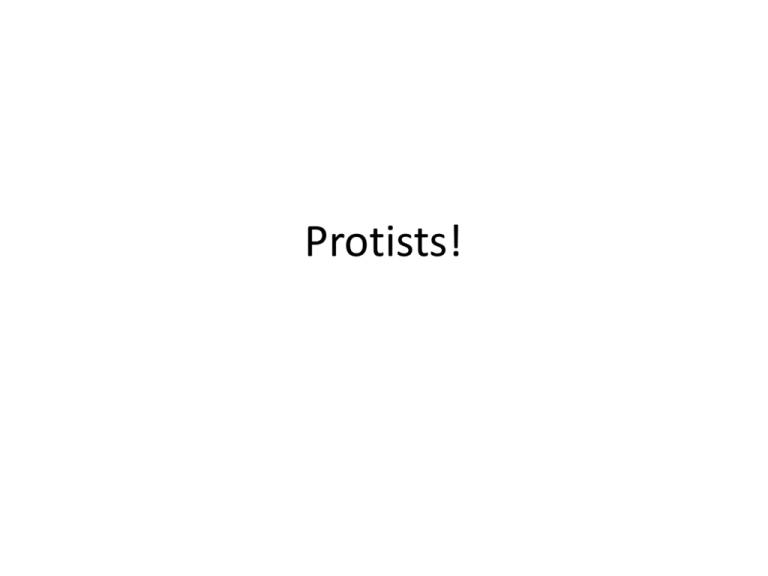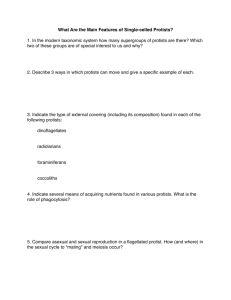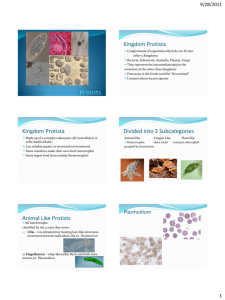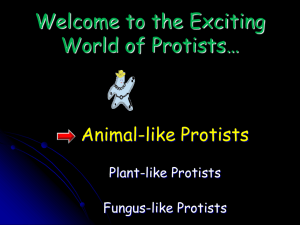Protists
advertisement

Protists! • What is a Protist? • Protists are organisms that are classified into the kingdom Protista. The protists form a group of organisms that really do not fit into any other kingdom. All protists are eukaryotic. That is, all protists have cells with nuclei. In addition, all protists live in moist environments. • Protists can be unicellular or multicellular. Protists can be microscopic or can be over 100 meters (300 feet) long. Some protists are heterotrophs, while others are autotrophs. • Since protists vary so much, we will group them into three subcategories: animal-like protists, fungus-like protists, and plant-like protists. Animal Like Protists • Protists that are classified as animal-like are called protozoans and share some common traits with animals. All animal-like protists are heterotrophs. Likewise, all animal-like protists are able to move in their environment. Unlike, animals, however, animal-like protists are all unicellular. Animal-like protists are divided into four basic groups based on how they move and live. • PROTISTS WITH PSEUDOPODS: • These protists move by extending their bodies forward and then pulling the rest of their bodies forward as well. The finger-like structures that they project forward are called pseudopods. The pseudopods are also used to trap food. The ameba is an example of this type of animal-like protist. PROTISTS WITH CILIA • These protists move by beating tiny hair-like structures called cilia. The cilia act as tiny oars that allows the protist to move through its watery environment. The cilia also help the protists capture food. The paramecium is an example of this type of animal-like protist. PROTISTS WITH FLAGELLA • These protists move by beating their long whiplike structures called flagella. These protists can have one or more flagella that help them move. Many of these protists live in the bodies of other organisms. The symbiosis may be mutualistic or parasitic. Giardia: water borne illness FUNGUS LIKE PROTISTS • Fungus-like protists are heterotrophs with cell walls. They also reproduce by forming spores. All fungus-like protists are able to move at some point in their lives. There are essentially three types of fungus-like protists: water molds, downy mildews, and slime molds. Water molds and Downy mildew • Live in water or moist environments • Look like tiny threads with a fuzzy covering • Attack food such as potatoes, cabbage, and corn and can destroy whole crops SLIME MOLDS • Live in moist soil and on decaying plants and trees • Very colorful • Move by forming pseudopods • Feed on bacteria and other microorganisms. Plant like Protists • Plant-like protists are autotrophic. They can live in soil, on the bark of trees, in fresh water, and in salt water. These protists are producers. They produce a lot of oxygen and carbon based organic materials. These plantlike protists form the base of aquatic food chains. • These plant-like protists can be unicellular, multicellular, or live in colonies. The plantlike protists are divided into four basic groups: euglenoids, dinoflagellates, diatoms, and algae. Euglenoids • • • • • Autotrophs when sunny Heterotrophs when dark Unicellular Found mostly in fresh water Some have flagellum EUGLENA Dinoflagellates • • • • • Autotrophs when sunny Heterotrophs when dark Unicellular Found mostly in fresh water Some have flagellum Dinoflagellates Diatoms • Unicellular • Glasslike cell walls – Used in toothpastes, scouring products, and as filters Green Algae • Are green in color • Mostly unicellular, but some form colonies, and a few are multicellular • Live in fresh water, salt water, and a few live on land Red Algae • • • • Multicellular Commonly called sea weed Live in deep salt water Are used by humans to help make ice cream and hair conditioner • Are eaten in some Asian cultures Brown Algae: “sea weed” • • • • • • • Multicellular Commonly called sea weed Have large leaf-like structures called blades Have air-filled sacs called air bladders Have root-like structure called holdfast Live in salt water Are used by humans to help make pudding and salad dressing Brown Algae






